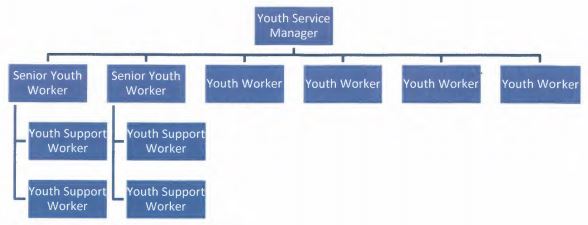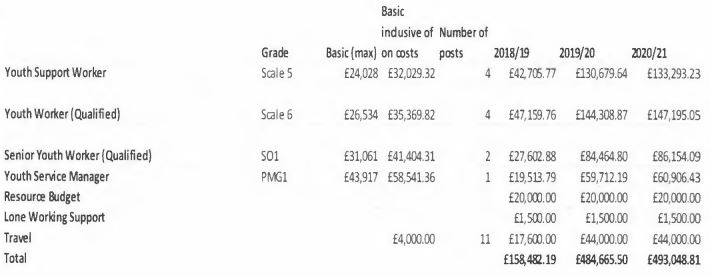Decision Record 98 Youth Service 2019


DECISION RECORD
Decision Record Number 98
This document records a decision taken by the Police, Fire and Crime Commissioner, together with details of the advice he received prior to taking the decision.
Decision taken:
The Police, Fire and Crime Commissioner has taken the decision to:
To establish a Youth Service that can contribute effectively towards improving the quality of life and achievements of young people. The service will work in a targeted way support young people’s successful transition into adulthood, recognising the need for young people to be diverted from anti-social behaviour and criminal activity at the earliest opportunity, and that positive, supportive role models are critical to young people forging strong trusting relationships of their own which will support them in making positive choices.
Details of advice taken:
Professional financial and legal advice has been sought to ensure the decision best supports business need and represents value for money.

Stephen Mold
Police, Fire and Crime Commissioner
09/01/2019
END
Northamptonshire Police, Fire and Crime Commission
Supporting Report to the Police, Fire and Crime Commissioner
Date of Report: 4th January 2019
Subject: Youth Service for Northamptonshire
Report Author: Nicci Marzec
1. Purpose of Report
1.1 The purpose of this report is to set the benefits of the establishment of a new Youth Service provision for Northamptonshire.
2. Decision(s) Recommended:
2.1 To establish a Youth Service that can contribute effectively towards improving the quality of life and achievements of young people. The service will work in a targeted way support young people’s successful transition into adulthood, recognising the need for young people to be diverted from anti-social behaviour and criminal activity at the earliest opportunity, and that positive, supportive role models are critical to young people forging strong trusting relationships of their own which will support them in making positive choices.
3. Relevant background / Chronology of Key Events:
3.1 The government policy for young people, Positive for Youth (2011)” set out a shared vision for how all parts of society, can work together to improve outcomes for young people. This means working towards common goals of young people having a sense of belonging, and the supportive relationship, strong ambitions, and good opportunities they need to realise their potential”.
3.2 The LGA’s recent publication ‘Bright Futures: our vision for youth services’ is based on existing good practice around the country, and feedback from councils, partners and practitioners. It is our ambition that this resource will provide a starting point in taking a fresh look at youth provision, encouraging true collaboration between all providers, to give every young person the bright future they deserve.
3.3 It is recognised nationally that the provision of dedicated youth services has been severely impacted on by financial decisions at a local level. Local children’s services authorities have a statutory responsibility to make sure, as far as possible, that there is sufficient provision of educational and recreational leisure-time activities for young people aged 13-19 (or up to 25 for those with learning difficulties). In many local authority areas the offer available through local leisure services, voluntary sector and clubs and societies has been deemed to deliver that requirement and the dedicated youth services which used to provide the specialism of youth work no longer exist.
3.4 In Northamptonshire youth service provision became a commissioned service in 2006. The process of commissioning by lots resulted in provision by a range of providers across the county and contract values which depreciated over time. There is currently no commissioned youth service provision in the county other than small specialist provisions to work specifically with young people on the edge of care.
3.5 The need for a distinct “youth” service is based on the specific needs of young people in the second most developmental phase of their lives, in a period in which they are developing physically and emotionally but also entering the second critical phase of brain development.
3.6 In 2016, UNICEF hosted The Adolescent Brain: A second window of opportunity, a symposium that brought together experts in adolescent neuroscience to discuss this emerging science and how we can apply it to support all adolescents – but especially those already facing risks to their well-being, including poverty, deprivation, conflict and crisis. They highlight some of the risks to optimal development – including toxic stress, which can interfere with the formation of brain connections, and other vulnerabilities unique to the onset of puberty and independence. They also point to the opportunities for developing interventions that can build on earlier investments in child development – consolidating gains and even offsetting the effects of deficits and traumas experienced earlier in childhood. Evidence shows that practical approaches – including safe and secure environments, or the presence of a caring adult – can help counteract the effects of trauma and lay a better foundation for optimal development.
3. 7 The service will predominantly focus on the provision of detached and outreach youth work which can be easily deployed at locations across the county according to areas of need. Detached youth work operates without the use of a building or activity and takes place where young people “are at” both geographically and developmentally. It delivers informal and social education and addresses whatever needs are presented to or perceived by the youth worker. As detached youth workers have no physical building or specific activity over which they have power or control, the relationship between young person and youth worker is entirely voluntary and constantly up for negotiation.
3.8 The aims of detached youth work is to provide young people with access to informal learning, opportunities, information and resources ‘on their own turf’ to stimulate, challenge and empower young people. The service will also work alongside other specialist services to ensure that the specific needs of individual young people are met, for example, joint work with substance misuse services where there is an identified substance related issue.
3.9 The Youth Service Manager will be directly accountable to and line managed by the Director for Early Intervention in the OPCC. Reporting Lines for other staff are outlined below.

3.10 This is a new function within the county and one which, given the fluid nature of service provision within the county, will be aligning to other new structures which are yet to be finalised, requires considerable flexibility in the early development stages to respond to the changing environment and culture in which it is operating.
3.11 The service will need to work collaboratively with partners as part of the Early Help provision within the county and will have interdependency with Social Care, Targetted O – 19 support, Child and Adolescent Mental Health Services (CAMHS), ACE Co-ordinators, schools, Youth Offending Service, Voice, Borough and District locality teams, neighbourhood policing teams and voluntary sector youth activity providers.
3.12 Performance measures will form a combination of quantitative and qualitative measures with proxy indicators to indicate level of impact on the wider system. Numeric indicators will relate to the number of geographical deployments, referrals from schools and other agencies and the number of young people engaged.
3.13 Evaluation of service interventions will demonstrate how work with young people has resulted in positive change in the short term. Development of intermediate and longer-term outcomes will be aligned to priority outcomes for local young people including sustained engagement with education and training, reduction in negative behaviours, positive family and community relationships. Outcomes for young people will be measured individually using measurement tools like Outcomes Stars.
3.14 It is anticipated that wider proxy indicators of success will be used to demonstrated impact on the wider service system. Indicators, previously part of the national indicator set, will include
• Improved perception of anti-social behaviour in the local area
• Improved perception of Police and local agencies dealing with concerns about anti-social behaviour
• Improvement in young people’s participation in positive activities
• Reduction in first time entrants to the Youth Justice System 10 – 17
• Reduction in number of permanent and fixed term exclusions from school.
• Reduction in substance misuse by young people engaged with the service
• Reduction in young people engaged with the service who are not in education, training or employment (NEET).
3.15 The service will have to work collaboratively and, at times, alongside the support provided by other agencies. Many young people may be mentored by a youth worker whilst receiving support from CAMHS or for substance misuse and it is important to note that in that regard the contribution that the service will make within the county to a broader range of targets impacting on the lives of children and young people. Similarly supporting a young person to stay at school and achieve formal qualifications will contribute to overall attainment targets for the county but will be insufficient in percentage change effect to be directly attributable. These outcomes will be measured on an individual basis for young people engaged with the service.
4. Consultation:
4.1 No formal consultation has been undertaken. The outline proposal has been discussed with colleagues in partners agencies including senior leadership colleagues including those on the Health and Wellbeing Board, Children’s Safeguarding Board and the YOS Management Board. Specific discussions have been had with Children’s Services and Police colleagues to ensure that this proposal is aligned to other activities and does not duplicate existing services. However, given that there is no NCC funded or commissioned targeted youth provision within the county this proposal does not replicate any existing provision and will be focussed on prevention of ACE factors which are proven to include the future likelihood of engaging in crime and anti-social behaviour.
5. Compliance Issues:
5.1 Is this a decision of ‘significant public interest?’
5.1.1 The level of investment and the countywide scope of the service to the public is such that this is a decision of significant public interest.
5.2 Is the recommended decision consistent with the priorities set out in the Northamptonshire Police and Crime Plan 2017/21?
5.2.1 The proposal is consistent with the PFCCP objectives to keep the young safe and protecting people from harm.
5.3 What are the financial and procurement implications of this decision?
5.3.1 Costs have been calculated based on current financial year salary information. Costs will be pro rata for 2018/19 and in subsequent years salary costs have assumed a minimum 2% cost of living increase. Travel has been calculated based on £4,000 per post per annum, however, it is anticipated that here will be variations between roles and that the overall budget will accommodate the travel costs of the team as a whole.

5.4 Will further decisions be required?
5.4.1 This is a three year proposal which will be evaluated during the period of funding. If the proposal is recommended to continue after the initial three year period a further decision would be sought.
5.5 Legal Implications
5.5.1 There are no specific legal implications arising from this proposal.
5.6 Risk Management
5.6.1 No risks identified. Management of the service will be compliant with the Safeguarding requirements of the Northamptonshire Safeguarding Children’s Board.
5.7 Has an Equality Impact Assessment been undertaken?
5.7.1 Youth work activities are designed to promote equality of opportunity through the challenging of oppressions such as racism and sexism and all those, which spring from differences of culture, race, language, sexual identity, gender, disability, age, religion and class; and through the celebration of the diversity and strengths, which arise from those differences.
6. Evaluation of alternative option(s):
6.1 In developing the proposal consideration has been given to both commissioned and directly employed models.
6.2 A predominant concern with regard to a commissioned model is the lack of a strong market for youth services since local authority funding cuts started in 2010. In most areas of the country youth services were significantly impacted by funding cuts with few areas of the country retaining any significant provision. In Northamptonshire Youth Services had been procured externally since 2006 and even before the financial cuts of 201 O the county had not been successful in attracting any of the larger national providers into the county. In addition, the propensity of NCC to procure in multiple “lots” within the county has meant that contracts were awarded to multiple providers, not as a single county-wide service.
6.3 The size of the contract would also require compliance with OJEU regulations and would take approximately 3 – 4 months. Assuming that, following the tender process, it was possible to award a contract, at that point the provider would need to commence recruitment as the lack of existing large youth service providers locally or at a national level would mean that any external provider would have a similar standing start in terms of recruitment as would be the case with direct recruitment.
6.4 It is generally difficult to get the same degree of flexibility in commissioned services as contractual and monitoring arrangements tend, through necessity, to be more rigid making it harder to respond quickly to the changing nature of the community and demographics. It is also the case that many of the in-kind benefits, like access to buildings, equipment and integration with existing OPCC management arrangements can be accommodated without additional cost. Management and premises costs associated with procured services are typically 10 – 20% of the contract value which would have a significant impact on the size of the service delivering to young people. This is also reflected in the increasing number of local authorities who are taking previously outsourced services back in house in the current financial climate.
6.5 Direct employment will give greater flexibility in developing the service to ensure that it is responsive to the needs of partners and young people, especially given it is an outreach service which will be deployed according to need rather than working in a routine and prescriptive way.
6.6 Direct employment will give greater control in developing the culture and ethos of the service from recruitment through to service development. In addition the service will have to develop alongside other new and complementary services in the county, for example the Prevention and diversion service which has received Home Office funding to work more specifically with young people on the edges of gang involvement. As the two services are implemented it is likely that there will be some changes and amendments to the cohorts and pathways that each will work with. The need to be able to respond flexibly to service development in this way further supports the need to have direct management control rather than management through contractual arrangements.
6. 7 The success of this project will be a result of getting experienced, knowledgeable, flexible and committed staff and retaining them. It is imperative the roles are filled with the best candidates and as a result, it may not be possible to recruit the full team in one recruitment exercise and employment may have to include long-term secondments from partner organisations.
6.8 It is also recommended that, to attract the best candidates that the roles are advertised as permanent rather than fixed term. This may result in potential redundancy costs at the end of the three-year period if the function is not going to continue. Potential redundancy costs depend on the redundancy entitlement (in weeks) of the post holders based on continuous years service with organisations covered by the Redundancy Modifications Order. A reasonable mid case assumption for planning purposes would be 10 weeks entitlement, £63k, excluding any pension strain costs if applicable. Recruitment to a three-year fixed term contract would result in the same liability but would potentially restrict the pool of applicants.
7. List of background reports used to compile this report:
None
8. List of appendices accompanying this report (if any):
None
9. Approvals Date
Has this report been approved by the author’s line manager?
Has this report been approved by the Chief Executive?